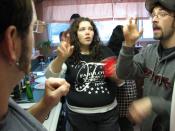IntroductionThis report is based on the article ÃÂArbitrariness and Iconicity: Historical Change in American Sign LanguageÃÂ (Language 51, 1975) by Nancy Frishberg. First we will summarise FrishbergÃÂs article and explain her objectives. In the second part we will elaborate over four different words and their reduction of iconicity over the years. The article explicitly describes the changes up till 1975 and the changes after this era as in the ASL dictionary of 1981 will have no effect on our description although may be named.
Most researchers of sign languages share the opinion that big parts of the sign interference of sign languages have gesticulate and iconic origin. Iconicity in sign language represents the signs where the signifier resembles the signified, e.g., a picture. This means that the signer mimes a sign which resembles the real-world object relating to or having the characteristics of an image. Laymen in sign language are able to understand the signs when they are iconic, but have no clue about the meaning when the sign is completely arbitrary.
Between these two extremes there are also half-transparent signs; signs that are not understood readily, but after knowing what it refers to causes an ÃÂaha-erlebnisÃÂ in which the link between the sign and the concept is recognised. Important is the observation of Frishberg (1975: 700) that attributable to historical evolution of the signs their iconicity evaporates partially; ÃÂSigns change away from their pantomimic or imitative origins to more arbitrary shapes.ÃÂ The question is to what degree this iconicity fades away and, even more important, why. To find out more about this tendency, the way signs were produced in the past and the modern forms have to be compared and contrasted. The information about the signs is found in sign dictionaries. For this essay we have used FrishbergÃÂs...


